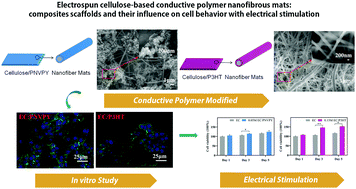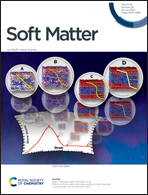Electrospun cellulose-based conductive polymer nanofibrous mats: composite scaffolds and their influence on cell behavior with electrical stimulation for nerve tissue engineering
Abstract
The fabrication of scaffolds with suitable chemical, physical, and electrical properties is critical for nerve cell adhesion and proliferation. Recently, electrical stimulation on conductive polymers has been applied to construct functional nerve cell scaffolds. Herein, we prepared natural polymer (cellulose)/conductive polymer nanofibrous mats, i.e., electrospun cellulose (EC)/poly N-vinylpyrrole (PNVPY) and EC/poly(3-hexylthiophene) (P3HT) through an efficient in situ polymerization method. The surface immobilization was characterized by optical microscopy (OM), scanning electron microscopy (SEM), Fourier transform infrared (FTIR) spectroscopy, hydrophilicity, porosity, and cyclic voltammetry. The OM and SEM images showed that PNVPY formed polymer coatings and aggregated nanoparticles on the EC nanofibers, while P3HT only produced polymer coatings. Compared with pure EC mats, both the composite mats had increased thickness, higher porosity, and higher conductivity. Also, an increase in hydrophilicity was found for EC/P3HT. In vivo cytocompatibility of the undifferentiated PC12 cells showed that the EC/PNVPY and EC/P3HT scaffolds exhibited favorable cell activity, adhesion, and proliferation. Furthermore, the results of electrical stimulation experiments indicated that the EC/P3HT mats could effectively promote the proliferation of the PC12 cells more than the EC and EC/PNVPY mats. The findings suggest a positive outcome regarding the conductive polymer-modified EC/PNVPY and EC/P3HT nanofibrous mats in neural tissue engineering.



 Please wait while we load your content...
Please wait while we load your content...